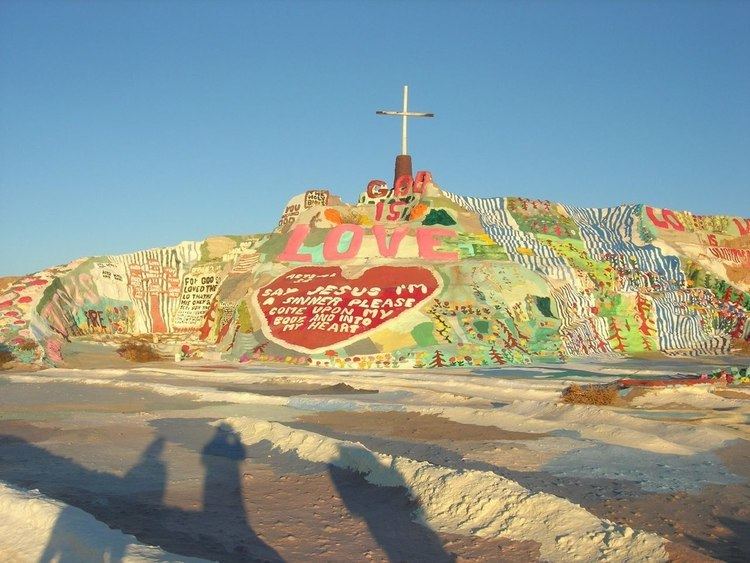 | ||
Hours Open today · 6:30AM–7PMCesar Chavez Day might affect these hoursFriday(Cesar Chavez Day)6:30AM–7PMHours might differSaturday6:30AM–7PMSunday6:30AM–7PMMonday6:30AM–7PMTuesday6:30AM–7PMWednesday6:30AM–7PMThursday6:30AM–7PMSuggest an edit Similar Salton Sea, East Jesus, Joshua Tree National, International Banana Museum, Cabazon Dinosaurs | ||
Can salvation mountain be saved
Salvation Mountain is a visionary environment covering a hill in the Colorado Desert, north of Calipatria, northeast of Niland near Slab City, several miles from the Salton Sea. It is in Imperial County, California.
Contents
- Can salvation mountain be saved
- Stalkin salvation mountain slab city
- The Second Mountain
- Paint toxicity concerns
- Formations
- Media appearances
- References
The artwork is made from adobe, straw, and thousands of gallons of lead-free paint. Salvation Mountain was created by local resident Leonard Knight (1931–2014). It encompasses numerous murals and areas painted with Christian sayings and Bible verses, though its philosophy was built around the Sinner's Prayer.
The Folk Art Society of America declared it "a folk art site worthy of preservation and protection" in the year 2000. In an address to the United States Congress on May 15, 2002, California Senator Barbara Boxer described it as "a unique and visionary sculpture... a national treasure... profoundly strange and beautifully accessible, and worthy of the international acclaim it receives".
In December 2011, the 80-year-old Knight was placed in a long-term care facility in El Cajon for dementia. Leonard Knight died on February 10, 2014, in El Cajon.
Concern has been raised for the future of the site, which requires constant maintenance due to the harsh surrounding environment. Many visitors bring paint to donate to the project, and a group of volunteers has been working to protect and maintain the site. In 2012, a public charity, Salvation Mountain, Inc., was established to support the project.
Stalkin salvation mountain slab city
The Second Mountain
The current Salvation Mountain is actually the second of its kind. Knight began the first Salvation Mountain in 1980, though it was incredibly unstable. The Mountain fell into a heap of rubble, though Knight was not discouraged; he rather saw it as God's way of letting him know the Mountain was not safe. He began a second Salvation Mountain, the one currently standing, stating that he had the chance this time to "do it with more smarts".
Paint toxicity concerns
In July, 1994, Imperial County hired a toxic waste specialist to test the soils around Salvation Mountain, with results showing high levels of lead toxicity. Knight and his supporters gathered signatures for a second test to be done by an independent party of his choosing. That test came back negative, supporting Knight's claim that he used non-toxic paints and that there were no toxins in the soil.
Formations
In 1998, Knight wanted to expand the mountain a bit. He gathered ideas from the Native Americans in the area around Salvation Mountain, which happen to be the Navajo. The Navajo are known for their architectural expertise. Their pueblitos inspired Knight and he then began forming the Hogan. It is a dome-like structure made of adobe and straw that insulates from heat. Knight intended to live in it, though he always preferred to live in his truck.
Knight also began what he liked to call "the museum". It is modeled after a hot air balloon Knight tried to create before Salvation Mountain. He intended the balloon to be seen by all below it, as it stated "GOD IS LOVE" in bright red on a white fabric. This ideal carried over to Salvation Mountain. The museum is a semi dome structure in the mountain that contains several small items given to him by friends and visitors. Each item has a significance and more often than not, visitors seek out Salvation Mountain to pray and leave an item at the mountain as symbolism of giving themselves to God. The museum is held up by adobe and straw, but also by car parts and a beautifully chaotic tangle of trees that twist within the dome and reach through the top.
